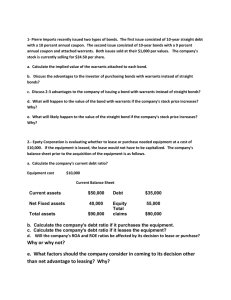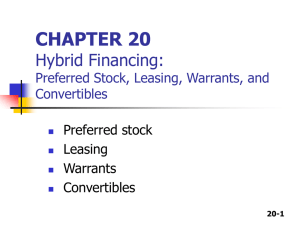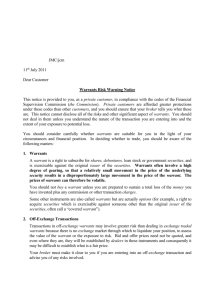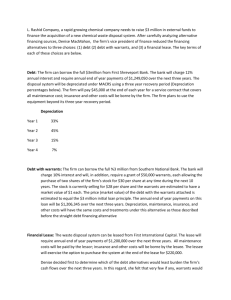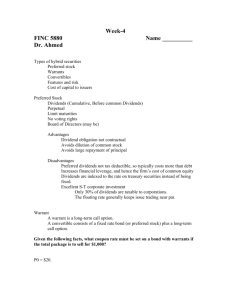CHAPTER 20 Hybrid Financing: Preferred Stock, Leasing, Warrants
advertisement
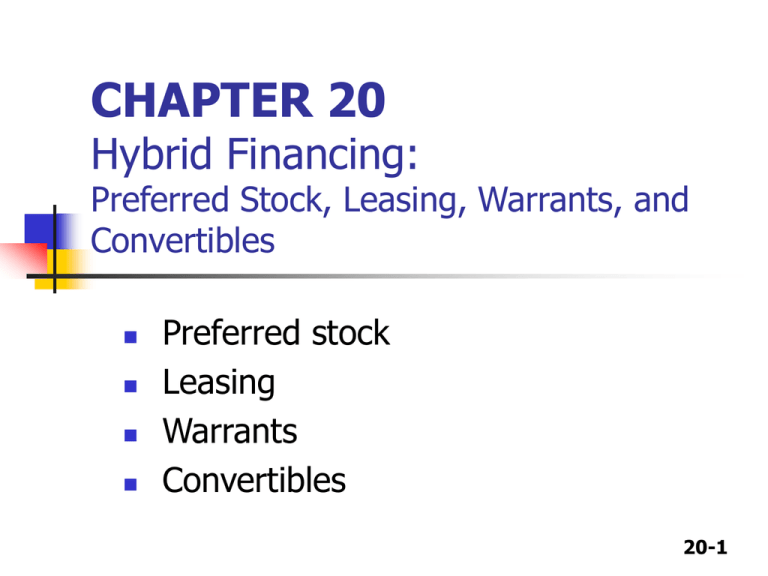
CHAPTER 20 Hybrid Financing: Preferred Stock, Leasing, Warrants, and Convertibles Preferred stock Leasing Warrants Convertibles 20-1 Leasing Often referred to as “off balance sheet” financing if a lease is not “capitalized.” Leasing is a substitute for debt financing and, thus, uses up a firm’s debt capacity. Capital leases are different from operating leases: Capital leases do not provide for maintenance service. Capital leases are not cancelable. Capital leases are fully amortized. 20-2 Analysis: Lease vs. Borrowand-buy Data: New computer costs $1,200,000. 3-year MACRS class life; 4-year economic life. Tax rate = 40%. kd = 10%. Maintenance of $25,000/year, payable at beginning of each year. Residual value in Year 4 of $125,000. 4-year lease includes maintenance. Lease payment is $340,000/year, payable at beginning of each year. 20-3 Depreciation schedule Depreciable basis = $1,200,000 MACRS Year Rate 1 0.33 2 0.45 3 0.15 4 0.07 1.00 Depreciation Expense $ 396,000 540,000 180,000 84,000 $1,200,000 End-of-Year Book Value $804,000 264,000 84,000 0 20-4 In a lease analysis, at what discount rate should cash flows be discounted? Since cash flows in a lease analysis are evaluated on an after-tax basis, we should use the after-tax cost of borrowing. Previously, we were told the cost of debt, kd, was 10%. Therefore, we should discount cash flows at 6%. A-T kd = 10%(1 – T) = 10%(1 – 0.4) = 6%. 20-5 Cost of Owning Analysis Analysis in thousands: 0 1 2 3 4 Cost of asset (1,200.0) Dep. tax savings1 158.4 216.0 72.0 33.6 Maint. (AT)2 (15.0) (15.0) (15.0) (15.0) Res. value (AT)3 ______ _____ _____ _____ 75.0 Net cash flow (1,215.0) 143.4 201.0 57.0 108.6 PV cost of owning (@ 6%) = -$766.948. 20-6 Notes on Cost of Owning Analysis Depreciation is a tax deductible expense, so it produces a tax savings of T(Depreciation). Year 1 = 0.4($396) = $158.4. 2. Each maintenance payment of $25 is deductible so the after-tax cost of the lease is (1 – T)($25) = $15. 3. The ending book value is $0 so the full $125 salvage (residual) value is taxed, (1 - T)($125) = $75.0. 1. 20-7 Cost of Leasing Analysis Analysis in thousands: A-T Lease pmt 0 1 2 3 -204 -204 -204 -204 4 Each lease payment of $340 is deductible, so the after-tax cost of the lease is (1-T)($340) = -$204. PV cost of leasing (@6%) = -$749.294. 20-8 Net advantage of leasing NAL = PV cost of owning – PV cost of leasing NAL = $766.948 - $749.294 (Dollars in thousands) = $17.654 Since the cost of owning outweighs the cost of leasing, the firm should lease. 20-9 Suppose there is a great deal of uncertainty regarding the computer’s residual value Residual value could range from $0 to $250,000 and has an expected value of $125,000. To account for the risk introduced by an uncertain residual value, a higher discount rate should be used to discount the residual value. Therefore, the cost of owning would be higher and leasing becomes even more attractive. 20-10 What if a cancellation clause were included in the lease? How would this affect the riskiness of the lease? A cancellation clause lowers the risk of the lease to the lessee. However, it increases the risk to the lessor. 20-11 How does preferred stock differ from common equity and debt? Preferred dividends are fixed, but they may be omitted without placing the firm in default. Preferred dividends are cumulative up to a limit. Most preferred stocks prohibit the firm from paying common dividends when the preferred is in arrears. 20-12 What is floating rate preferred? Dividends are indexed to the rate on treasury securities instead of being fixed. Excellent S-T corporate investment: Only 30% of dividends are taxable to corporations. The floating rate generally keeps issue trading near par. However, if the issuer is risky, the floating rate preferred stock may have too much price instability for the liquid asset portfolios of many corporate investors. 20-13 How can a knowledge of call options help one understand warrants and convertibles? A warrant is a long-term call option. A convertible bond consists of a fixed rate bond plus a call option. 20-14 A firm wants to issue a bond with warrants package at a face value of $1,000. Here are the details of the issue. Current stock price (P0) = $10. kd of equivalent 20-year annual payment bonds without warrants = 12%. 50 warrants attached to each bond with an exercise price of $12.50. Each warrant’s value will be $1.50. 20-15 What coupon rate should be set for this bond plus warrants package? Step 1 – Calculate the value of the bonds in the package VPackage = VBond + VWarrants = $1,000. VWarrants = 50($1.50) = $75. VBond + $75 = $1,000 VBond = $925. 20-16 Calculating required annual coupon rate for bond with warrants package Step 2 – Find coupon payment and rate. Solving for PMT, we have a solution of $110, which corresponds to an annual coupon rate of $110 / $1,000 = 11%. INPUTS OUTPUT 20 12 -925 N I/YR PV 1000 PMT FV 110 20-17 If after the issue, the warrants sell for $2.50 each, what would this imply about the value of the package? The package would have been worth $925 + 50(2.50) = $1,050. This is $50 more than the actual selling price. The firm could have set lower interest payments whose PV would be smaller by $50 per bond, or it could have offered fewer warrants with a higher exercise price. Current stockholders are giving up value to the warrant holders. 20-18 Assume the warrants expire 10 years after issue. When would you expect them to be exercised? Generally, a warrant will sell in the open market at a premium above its theoretical value (it can’t sell for less). Therefore, warrants tend not to be exercised until just before they expire. 20-19 Optimal times to exercise warrants In a stepped-up exercise price, the exercise price increases in steps over the warrant’s life. Because the value of the warrant falls when the exercise price is increased, step-up provisions encourage in-the-money warrant holders to exercise just prior to the step-up. Since no dividends are earned on the warrant, holders will tend to exercise voluntarily if a stock’s dividend rises enough. 20-20 Will the warrants bring in additional capital when exercised? When exercised, each warrant will bring in the exercise price, $12.50, per share exercised. This is equity capital and holders will receive one share of common stock per warrant. The exercise price is typically set at 10% to 30% above the current stock price on the issue date. 20-21 Because warrants lower the cost of the accompanying debt issue, should all debt be issued with warrants? No, the warrants have a cost that must be added to the coupon interest cost. 20-22 What is the expected rate of return to holders of bonds with warrants, if exercised in 5 years at P5 = $17.50? The company will exchange stock worth $17.50 for one warrant plus $12.50. The opportunity cost to the company is $17.50 - $12.50 = $5.00, for each warrant exercised. Each bond has 50 warrants, so on a par bond basis, opportunity cost = 50($5.00) = $250. 20-23 Finding the opportunity cost of capital for the bond with warrants package 0 Here is the cash flow time line: 1 4 5 6 ... +1,000 -110 19 20 -110 -110 -1,000 -1,110 ... -110 -110 -110 -250 -360 Input the cash flows into a financial calculator (or spreadsheet) and find IRR = 12.93%. This is the pre-tax cost. 20-24 Interpreting the opportunity cost of capital for the bond with warrants package The cost of the bond with warrants package is higher than the 12% cost of straight debt because part of the expected return is from capital gains, which are riskier than interest income. The cost is lower than the cost of equity because part of the return is fixed by contract. 20-25 The firm is now considering a callable, convertible bond issue, described below: 20-year, 10% annual coupon, callable convertible bond will sell at its $1,000 par value; straight debt issue would require a 12% coupon. Call the bonds when conversion value > $1,200. P0 = $10; D0 = $0.74; g = 8%. Conversion ratio = CR = 80 shares. 20-26 What conversion price (Pc) is implied by this bond issue? The conversion price can be found by dividing the par value of the bond by the conversion ratio, $1,000 / 80 = $12.50. The conversion price is usually set 10% to 30% above the stock price on the issue date. 20-27 What is the convertible’s straight debt value? Recall that the straight debt coupon rate is 12% and the bond’s have 20 years until maturity. INPUTS OUTPUT 20 12 N I/YR PV 100 1000 PMT FV -850.61 20-28 Implied Convertibility Value Because the convertibles will sell for $1,000, the implied value of the convertibility feature is $1,000 – $850.61 = $149.39. = $1.87 per share. The convertibility value corresponds to the warrant value in the previous example. 20-29 What is the formula for the bond’s expected conversion value in any year? Conversion value = Ct = CR(P0)(1 + g)t. At t = 0, the conversion value is … C0 = 80($10)(1.08)0 = $800. At t = 10, the conversion value is … C10 = 80($10)(1.08)10 = $1,727.14. 20-30 What is meant by the floor value of a convertible? The floor value is the higher of the straight debt value and the conversion value. At t = 0, the floor value is $850.61. C0 = $800. At t = 10, the floor value is $1,727.14. Straight debt value0 = $850.61. Straight debt value10 = $887.00. C10 = $1,727.14. Convertibles usually sell above floor value because convertibility has an additional value. 20-31 The firm intends to force conversion when C = 1.2($1,000) = $1,200. When is the issued expected to be called? We are solving for the period of time until the conversion value equals the call price. After this time, the conversion value is expected to exceed the call price. INPUTS N OUTPUT 8 -800 0 1200 I/YR PV PMT FV 5.27 20-32 What is the convertible’s expected cost of capital to the firm, if converted in Year 5? 0 1 1,000 -100 2 -100 3 -100 4 -100 5 -100 -1,200 -1,300 Input the cash flows from the convertible bond and solve for IRR = 13.08%. 20-33 Is the cost of the convertible consistent with the riskiness of the issue? To be consistent, we require that kd < kc < ke. The convertible bond’s risk is a blend of the risk of debt and equity, so kc should be between the cost of debt and equity. From previous information, ks = $0.74(1.08) / $10 + 0.08 = 16.0%. kc is between kd and ks, and is consistent. 20-34 Besides cost, what other factor should be considered when using hybrid securities? The firm’s future needs for capital: Exercise of warrants brings in new equity capital without the need to retire lowcoupon debt. Conversion brings in no new funds, and low-coupon debt is gone when bonds are converted. However, debt ratio is lowered, so new debt can be issued. 20-35 Other issues regarding the use of hybrid securities Does the firm want to commit to 20 years of debt? Conversion removes debt, while the exercise of warrants does not. If stock price does not rise over time, then neither warrants nor convertibles would be exercised. Debt would remain outstanding. 20-36
